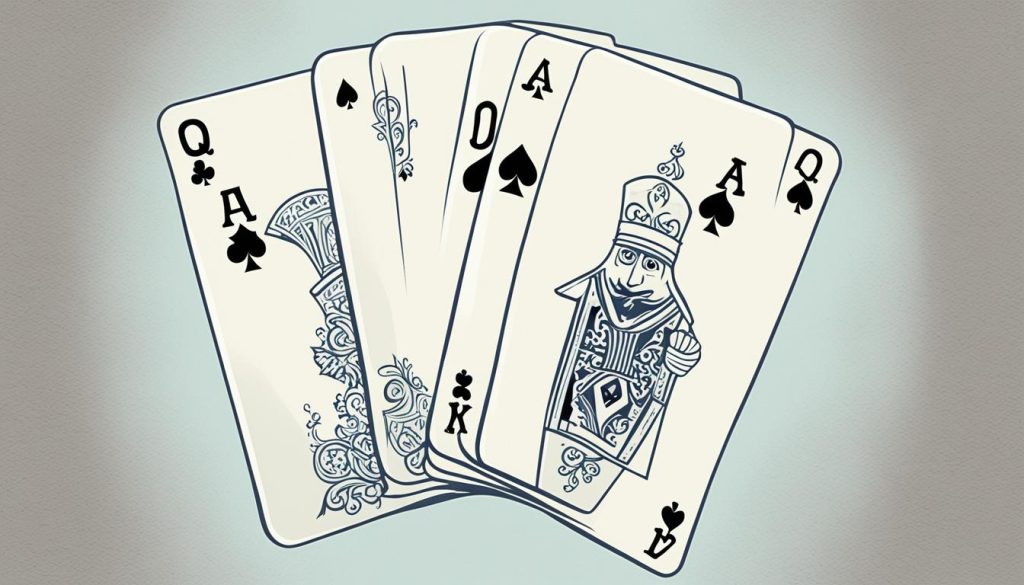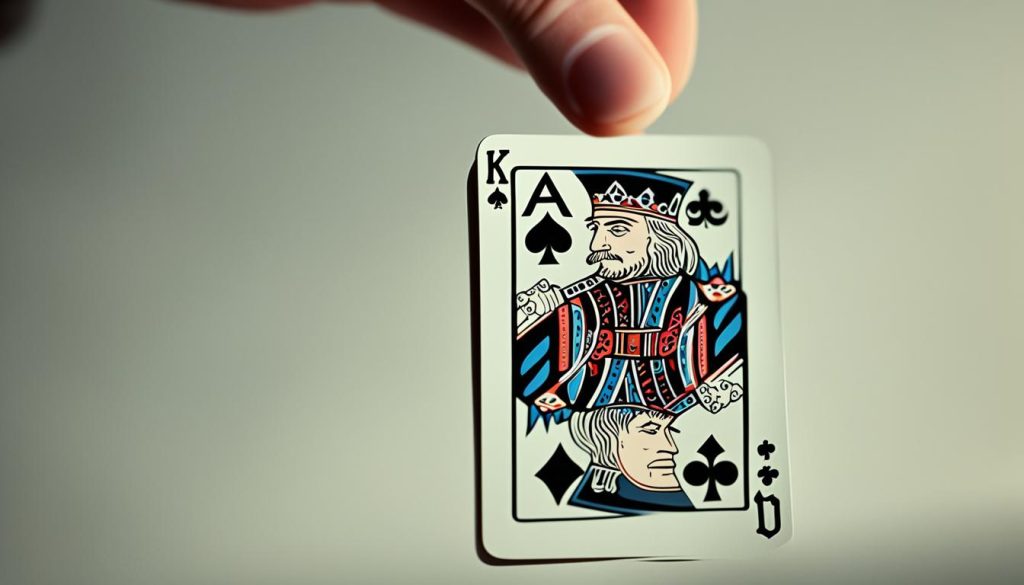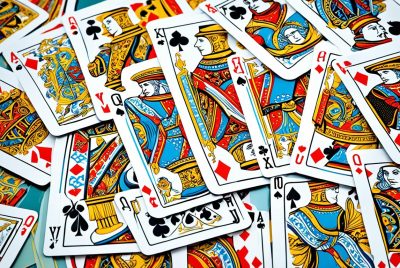Marking Cards in Card Games: Detecting and Preventing Cheating
Have you ever wondered if there are ways to detect cheaters in card games? How can you protect yourself from unfair play? Well, the answer lies in the art of card marking.
Marking cards is an age-old technique used by cheaters in card games, especially in poker. It involves making subtle marks or imperfections on the cards to gain an advantage over other players. Casinos have come a long way in improving their methods to catch cheaters, but card marking techniques continue to evolve, making it crucial for players to be aware and take precautions.
In this article, we will explore the different card marking techniques, signs of marked cards, and methods to prevent cheating in card games. We will also discuss how to detect and address cheating if it occurs. So let’s dive in and unravel the secrets of marking cards!
Key Takeaways:
- Marking cards is an old yet evolving technique used by cheaters in card games.
- Being observant and aware of suspicious behavior and card conditions can help detect cheats in the act.
- There are various card marking techniques, ranging from simple markings to advanced technologies.
- Signs of marked cards include unusual marks on the back, such as cuts or bent edges.
- Preventive measures like cautious seating arrangements and specific shuffling and dealing procedures can reduce the chances of cheating.
How Marking Cards Works
Cheaters employ various methods to mark cards, utilizing both simple techniques and advanced technologies. Understanding these different card marking techniques is crucial for players to protect themselves and maintain game integrity.
One common method cheaters use involves making slight markings on the edges of the cards. This can be done discreetly using fingernails or other small tools. These markings provide cheaters with valuable information about the cards’ identity without arousing suspicion.
Invisible ink is another popular choice for marking cards. This special ink is invisible to the naked eye but can be seen using specific techniques, such as wearing special glasses or using specific lighting conditions. Cheaters can apply this ink to covertly mark the cards and gain an advantage during gameplay.
Advanced marking techniques, such as luminous marking and juice-marking, take card marking to a whole new level. Luminous marking involves using a specific light source to reveal hidden marks on the cards, invisible to the unaided eye. Juice-marking, on the other hand, involves applying a translucent substance to the back of the cards, making the marks visible only under specific conditions. These advanced methods allow cheaters to read the marks discreetly, ensuring they remain undetected.
By being aware of these different marking methods, players can better protect themselves against cheating. They can keep a watchful eye out for any suspicious behavior and thoroughly inspect the cards for any signs of tampering or marking. Vigilance and awareness are key to ensuring a fair and enjoyable card game experience.

Signs of Marked Cards
Detecting cheating in card games can be a challenging task, but there are several signs that can indicate the presence of marked cards. By being attentive and observant, players can protect themselves from unfair play and maintain the integrity of the game.
Unusual Marks
One of the key signs of marked cards is the presence of unusual marks on the back of the cards. These marks can be in the form of small cuts, scratches, or slightly bent edges. Cheaters often mark important cards like aces and kings, allowing them to identify these cards during gameplay and gain an unfair advantage.
Suspicious Card Behavior
Another indication of marked cards is suspicious card behavior during a game. If there are consistently unusual hands or frequent big bluffs happening in a short period, it could be a sign that someone is cheating. Paying attention to these patterns and trusting your instincts is crucial in detecting cheating and ensuring a fair playing experience for all participants.
Report Suspicions
If you suspect that marked cards are being used, it is important to report your suspicions to the appropriate authorities. In a casino or an official poker room, you can notify the floor staff who will investigate the situation. In private games, it may be more challenging to address your concerns, considering the possibility of collusion. However, it is still important to communicate any suspicions to the group or game organizer to ensure a fair and honest playing environment.
Remaining vigilant and aware of these signs is essential in detecting cheating and maintaining the integrity of card games. By actively looking for unusual marks, observing card behavior, and reporting any suspicions, players can contribute to a fair and enjoyable gaming experience for everyone involved.

Preventing Cheating in Card Games
Preventing cheating in card games is crucial to ensure fair play and maintain the integrity of the game. Players can employ various measures to enhance card game security and minimize the risks of cheating.
Seating Arrangements
One important step in preventing cheating is to carefully consider the seating arrangement, especially in private games where collusion is more likely. By strategically placing players, you can minimize the opportunity for illicit cooperation and communication between individuals.
Shuffling and Dealing Procedures
Proper shuffling and dealing procedures are vital in preventing cheating. Consider implementing the following practices:
- Designate different players to shuffle, cut, and deal the cards in a specific order. This ensures that no single individual has complete control over the deck, reducing the chances of tampering.
- Utilize a postilion or joker card on the bottom of the deck. This prevents bottom dealing, a technique where cheaters deal cards from the bottom of the deck to gain an unfair advantage. The postilion or joker card acts as a safeguard against glimpses of the bottom card.
- Regularly count the cards before and after each game to ensure no cards are missing or added. This verification process helps maintain the integrity of the deck and prevents cheating through manipulation of the card count.
- Pay attention to the condition of the cards, checking for any unusual markings or signs of tampering. Regular inspection helps detect potential cheat methods such as card marking.
By implementing these preventive measures and staying vigilant, players can create a secure environment that discourages cheating and promotes fair play. Remember, maintaining game integrity is essential for an enjoyable and trustworthy card game experience.
Detecting and Addressing Cheating in Card Games
Detecting cheating in card games can be a challenging task, but there are effective methods that can be employed to identify and address potential cheaters. One such technique, the riffle test, can help detect cards that have been marked to gain an unfair advantage.
The riffle test involves holding the deck of cards with their backs up and riffling the cards from the bottom to the top, while carefully observing any movement in the back designs. Marked cards may exhibit animation or unusual movement, indicating potential cheating.
If you suspect cheating during a game, it is important to notify the appropriate authorities in a casino or poker room. In private games, players should exercise caution when addressing their concerns, considering the possibility of collusion.
Here is an example of how to perform the riffle test:
- Hold the deck of cards with the back designs facing up.
- Riffle the cards from the bottom to the top, paying close attention to any movement or changes in the back designs.
- If you notice any suspicious animation or unusual movement, it could indicate that the cards have been marked.
- In such cases, it is crucial to report your observations to the appropriate authorities, ensuring fair play for all participants.
By employing methods like the riffle test and promptly addressing suspicions of cheating, players can help maintain the integrity of card games and ensure a level playing field for everyone involved.
Conclusion
In card games, the practice of marking cards has been a persistent method of cheating, and it continues to adapt with advancements in technology and techniques. To ensure fair gameplay and protect themselves from marked cards, players must remain vigilant and take necessary precautions. By staying observant of suspicious behavior, meticulously checking for markings, and implementing preventive measures, players can uphold the integrity of the game and create a level playing field.
It’s important to note that while cheating exists, it should not deter players from enjoying the excitement of card games. Instead, players should empower themselves by being informed and educated about different cheating methods. With this knowledge, players can stay one step ahead and safeguard themselves against unfair play.
Ultimately, maintaining card game integrity is a collective effort. Casinos, poker rooms, and individuals must work together to establish effective security protocols and promote transparency. By working hand in hand, players can ensure that card games are enjoyed in an environment of trust and fairness, leaving no room for cheating and marking cards. Let’s strive for a clean and honest playing experience for everyone.
FAQ
What is card marking?
Card marking is a technique used by cheaters in card games to gain an unfair advantage. It involves marking the cards in a way that is not easily detectable by other players or casino staff.
How do cheaters mark cards?
Cheaters use various methods to mark cards, including making slight markings on the edges using fingernails, using invisible ink that can only be seen with special glasses or under specific lighting conditions, and using advanced techniques like luminous marking and juice-marking.
How can I detect marked cards?
Look for unusual marks on the back of the cards, such as small cuts or slightly bent edges. Pay attention to suspicious behavior and consistently unusual hands or frequent big bluffs. Trust your instincts and report any suspicions to the appropriate authorities.
What can I do to prevent cheating in card games?
Be cautious about the seating arrangement, especially in private games. Shuffle, cut, and deal the cards in a specific order, with different players performing each task. Use a postilion or joker card on the bottom of the deck to prevent bottom dealing and glimpses of the bottom card. Regularly count the cards and check for markings.
How can I detect and address cheating in card games?
One effective technique is the riffle test, where you hold the deck of cards with their backs up and riffling the cards from the bottom to the top while observing any movement in the back designs. If cheating is suspected, notify the appropriate authorities in a casino or poker room. In private games, be cautious about addressing your concerns, considering the possibility of collusion.
Is cheating common in card games?
While casinos have improved their methods of catching cheaters, card marking techniques continue to evolve. Cheating is more prevalent in private and underground games. It is important to protect yourself from marked cards, be aware of different marking methods, and take precautions to maintain game integrity.




